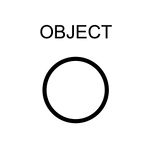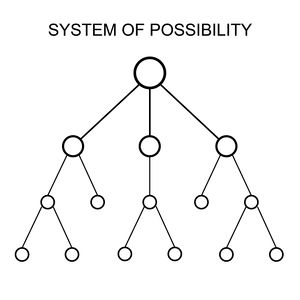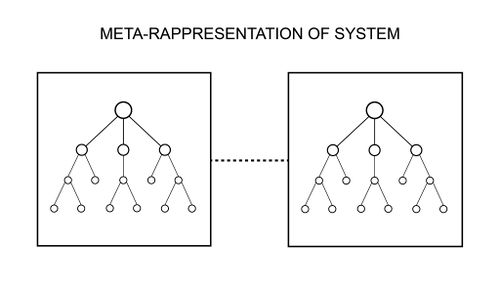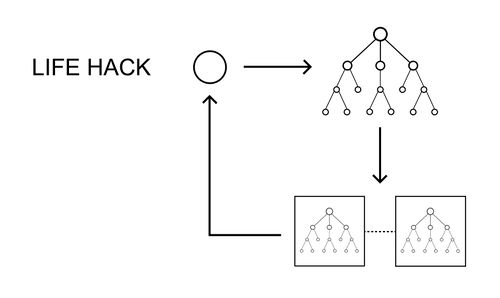Life Hacks Manifesto: Difference between revisions
| (42 intermediate revisions by 2 users not shown) | |||
| Line 1: | Line 1: | ||
__TOC__<br> | |||
Life hacks | =Life Hacks Manifesto (a life hack for making life hacks)= | ||
Life | ===Initial thoughts: Life Hacks in the work/home space=== | ||
* Overlap of work spaces and non-work spaces (making a work space more "comfortable" as well as making a non-work space more "workable") | |||
* Making “productive” spaces | |||
* Dealing with stress in the workplace | |||
* Re-adjusting the context of work/home according to needs | |||
==Material Adjustments (object-based)== | |||
===Using objects differently=== | |||
[[File: LifeHack-01-01.jpg | 150px]] | |||
''Thinking of how objects can be used differently leads to realising the interconnectivity of life hacks with other life hacks. There is a system of possibility leading from objects. <br><br> | |||
* Using a wooden plank across an armchair/bath to creake a makeshift desk | |||
* Exercising in your office by using a computer cable as a jumprope | |||
* Use PVC spiral cables to position cables for your computer and its peripherals | |||
== Contextual Adjustments (system-based)== | |||
===Re-configuration of systems (to produce different results)=== | |||
[[File: LifeHack-02.jpg | 300px]] | |||
''Recognizing systems of possibility around objects leads to thinking about the structure of systems that include both the material (objects) and immaterial(relationships between subjects and objects).'' <br><br> | |||
* A script that takes all of your files and puts them in one folder, effectively cutting down the data tree. | |||
* Using [https://addons.mozilla.org/en-US/firefox/addon/greasemonkey/ Greasemonkey] to customise web pages by styling them on the fly.<br> | |||
// | |||
==Immaterial Adjustments (Meta-representation of systems)== | |||
===Comparative analysis of spaces=== | |||
[[File: LifeHack-03.jpg | 500px]] | |||
''Examining the meta-representation of spaces can encourage evaluation of their effectivity, the relationship of the individual to them, and their relationships to each other (e.g how the workspace can effectively collapse within a home space and vice-versa).''<br><br> | |||
Simulating life in a virtually-free domain<br> | |||
* A videogame that you play when you have finished work in order to relieve stress. The game is set within your normal workspace, and the other players are the people you work with (in multiplayer mode). The physical workspace is replicated in the simulation, with alterations made based on sensors in your office. The tasks are your normal worktasks, which you can do if you like, or not. “Second Worklife”.<br> | |||
* A videogame that you play when you are at work in order to take care of domestic responsibilities. The game is set within your home, and the other players are the people you live with (in multiplayer mode). The physical home is replicated in the simulation, with alterations made based on sensors in your home. The tasks are your normal housework, which you can do if you like, or not. “Second Homelife”.<br> | |||
Delineating space<br> | |||
* If you work from home, mark out lines that separate your workspace from your non-workspace with tape on the floor. The visual cue will remind you to only do appropriate tasks in the appropriate spaces. | |||
* Swap 2 pieces of furniture from your office with those in your home, and vice-versa. | |||
==Reconnecting the immaterial to material== | |||
===Life Hacks=== | |||
[[File: LifeHack-04-04.jpg | 500px]] | |||
''"Life Hack" means the actual material practice of hacking life through mental process and their cognitive patterns, "Mind Hacks".'' <br> | |||
''In this way you can reappropriate the physical space, founding a perfect correspondance between your mind and your life.'' <br><br> | |||
Life Hacks reveal all the potential possibilities of an object. | |||
Life Hacks are about providing a context that elicits invention. | |||
A Life Hack is not a product you can buy (it doesn't come pre-packaged). | |||
Life Hacks are novel. | |||
Life Hacks show the recursive inner nature of themselves, as being itself a Life Hack, containing Life Hacks. | |||
Life Hacks are self-referential, as the term 'Life Hack' is an autology, and generate paradoxes capable of explaining its own self-referential nature and its usability. This means that you can infinitely life hack Life Hacks and found out how Life Hacks work. | |||
You can make Life Hacks with everything as well as with nothing. | |||
Life Hacks are *out of time* (not static) but constantly in evolution. | |||
The tagline of Life Hacks is 'Use your mind to make your life'. | |||
The aim of Life Hacks should be to encourage a "hacker mindset" in order to stimulate thinking and encourage idiosyncratic solutions, rather than apply "all-purpose" solutions. | |||
<br><br> | |||
[[Category: Start up, Burn out: Life Hacks]] | [[Category: Start up, Burn out: Life Hacks]] | ||
Latest revision as of 10:58, 11 October 2018
Life Hacks Manifesto (a life hack for making life hacks)
Initial thoughts: Life Hacks in the work/home space
- Overlap of work spaces and non-work spaces (making a work space more "comfortable" as well as making a non-work space more "workable")
- Making “productive” spaces
- Dealing with stress in the workplace
- Re-adjusting the context of work/home according to needs
Material Adjustments (object-based)
Using objects differently
Thinking of how objects can be used differently leads to realising the interconnectivity of life hacks with other life hacks. There is a system of possibility leading from objects.
- Using a wooden plank across an armchair/bath to creake a makeshift desk
- Exercising in your office by using a computer cable as a jumprope
- Use PVC spiral cables to position cables for your computer and its peripherals
Contextual Adjustments (system-based)
Re-configuration of systems (to produce different results)
Recognizing systems of possibility around objects leads to thinking about the structure of systems that include both the material (objects) and immaterial(relationships between subjects and objects).
- A script that takes all of your files and puts them in one folder, effectively cutting down the data tree.
- Using Greasemonkey to customise web pages by styling them on the fly.
Immaterial Adjustments (Meta-representation of systems)
Comparative analysis of spaces
Examining the meta-representation of spaces can encourage evaluation of their effectivity, the relationship of the individual to them, and their relationships to each other (e.g how the workspace can effectively collapse within a home space and vice-versa).
Simulating life in a virtually-free domain
- A videogame that you play when you have finished work in order to relieve stress. The game is set within your normal workspace, and the other players are the people you work with (in multiplayer mode). The physical workspace is replicated in the simulation, with alterations made based on sensors in your office. The tasks are your normal worktasks, which you can do if you like, or not. “Second Worklife”.
- A videogame that you play when you are at work in order to take care of domestic responsibilities. The game is set within your home, and the other players are the people you live with (in multiplayer mode). The physical home is replicated in the simulation, with alterations made based on sensors in your home. The tasks are your normal housework, which you can do if you like, or not. “Second Homelife”.
Delineating space
- If you work from home, mark out lines that separate your workspace from your non-workspace with tape on the floor. The visual cue will remind you to only do appropriate tasks in the appropriate spaces.
- Swap 2 pieces of furniture from your office with those in your home, and vice-versa.
Reconnecting the immaterial to material
Life Hacks
"Life Hack" means the actual material practice of hacking life through mental process and their cognitive patterns, "Mind Hacks".
In this way you can reappropriate the physical space, founding a perfect correspondance between your mind and your life.
Life Hacks reveal all the potential possibilities of an object.
Life Hacks are about providing a context that elicits invention.
A Life Hack is not a product you can buy (it doesn't come pre-packaged).
Life Hacks are novel.
Life Hacks show the recursive inner nature of themselves, as being itself a Life Hack, containing Life Hacks.
Life Hacks are self-referential, as the term 'Life Hack' is an autology, and generate paradoxes capable of explaining its own self-referential nature and its usability. This means that you can infinitely life hack Life Hacks and found out how Life Hacks work.
You can make Life Hacks with everything as well as with nothing.
Life Hacks are *out of time* (not static) but constantly in evolution.
The tagline of Life Hacks is 'Use your mind to make your life'.
The aim of Life Hacks should be to encourage a "hacker mindset" in order to stimulate thinking and encourage idiosyncratic solutions, rather than apply "all-purpose" solutions.




